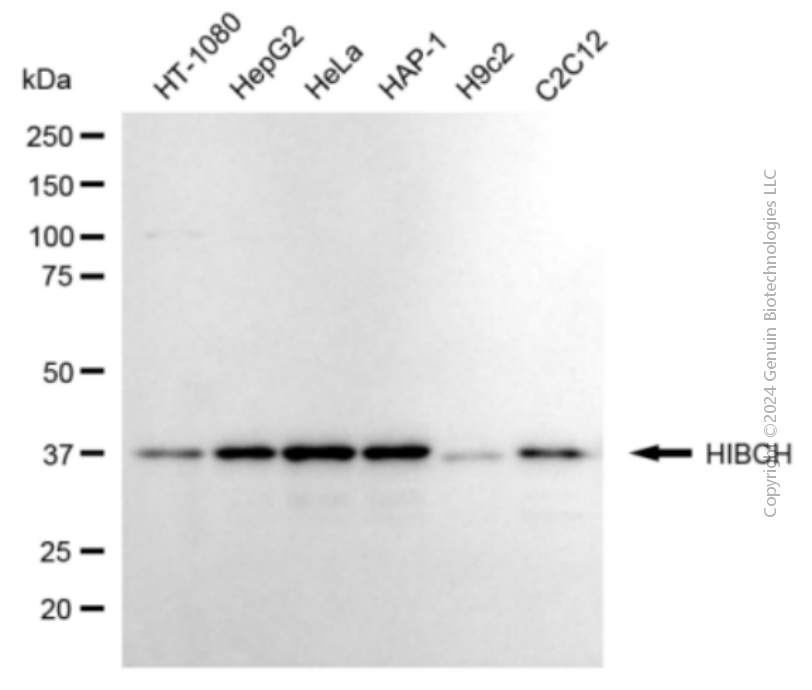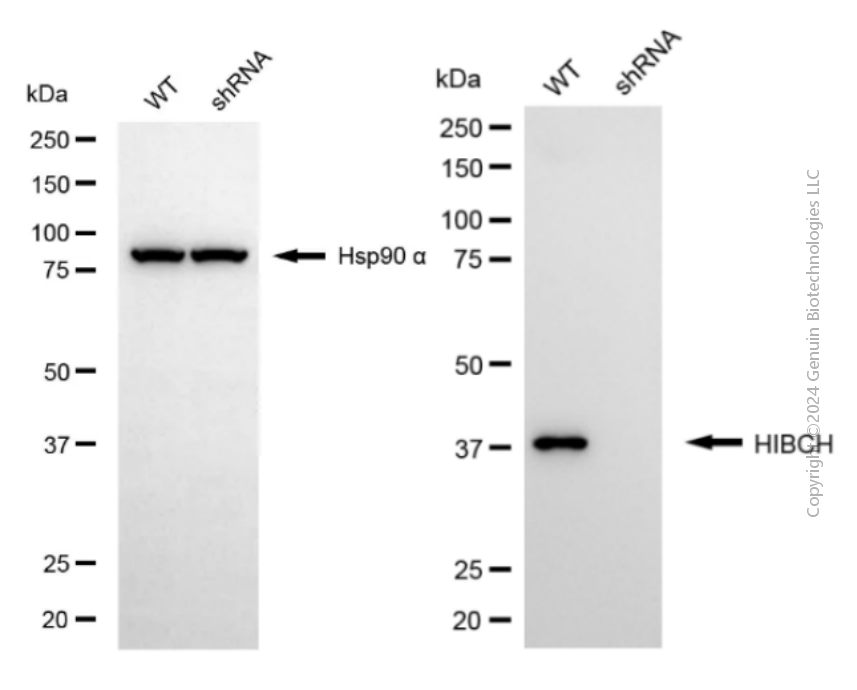KD-Validated Anti-HIBCH Mouse Monoclonal Antibody
Mouse monoclonal antibody
- SPECIFICATION
- CITATIONS
- PROTOCOLS
- BACKGROUND

Application
| WB |
|---|---|
| Primary Accession | Q6NVY1 |
| Reactivity | Rat, Human, Mouse |
| Clonality | Monoclonal |
| Isotype | Mouse IgG2a |
| Clone Names | 24GB13045 |
| Calculated MW | Predicted, 43 kDa, observed, 37 kDa |
| Gene Name | HIBCH |
| Aliases | HIBCH; 3-Hydroxyisobutyryl-CoAHydrolase; 3-Hydroxyisobutyryl-Coenzyme A Hydrolase; 3-Hydroxyisobutyryl-CoA Hydrolase, Mitochondrial; HIB-CoA Hydrolase; HIBYL-CoA-H; EC 3.1.2.4; Testicular Tissue Protein Li 86; HIBYLCOAH |
| Immunogen | Recombinant protein of human HIBCH |
| Gene ID | 26275 |
|---|---|
| Other Names | 3-hydroxyisobutyryl-CoA hydrolase, mitochondrial, 3.1.2.4, 3-hydroxyisobutyryl-coenzyme A hydrolase, HIB-CoA hydrolase, HIBYL-CoA-H, HIBCH |
| Name | HIBCH |
|---|---|
| Function | Hydrolyzes 3-hydroxyisobutyryl-CoA (HIBYL-CoA), a saline catabolite. Has high activity toward isobutyryl-CoA. Could be an isobutyryl-CoA dehydrogenase that functions in valine catabolism. Also hydrolyzes 3-hydroxypropanoyl-CoA. |
| Cellular Location | Mitochondrion. |
| Tissue Location | Highly expressed in liver and kidney, also detected in heart, muscle and brain (at protein level). Not detected in lung |

Thousands of laboratories across the world have published research that depended on the performance of antibodies from Abcepta to advance their research. Check out links to articles that cite our products in major peer-reviewed journals, organized by research category.
info@abcepta.com, and receive a free "I Love Antibodies" mug.
Provided below are standard protocols that you may find useful for product applications.
If you have used an Abcepta product and would like to share how it has performed, please click on the "Submit Review" button and provide the requested information. Our staff will examine and post your review and contact you if needed.
If you have any additional inquiries please email technical services at tech@abcepta.com.














 Foundational characteristics of cancer include proliferation, angiogenesis, migration, evasion of apoptosis, and cellular immortality. Find key markers for these cellular processes and antibodies to detect them.
Foundational characteristics of cancer include proliferation, angiogenesis, migration, evasion of apoptosis, and cellular immortality. Find key markers for these cellular processes and antibodies to detect them. The SUMOplot™ Analysis Program predicts and scores sumoylation sites in your protein. SUMOylation is a post-translational modification involved in various cellular processes, such as nuclear-cytosolic transport, transcriptional regulation, apoptosis, protein stability, response to stress, and progression through the cell cycle.
The SUMOplot™ Analysis Program predicts and scores sumoylation sites in your protein. SUMOylation is a post-translational modification involved in various cellular processes, such as nuclear-cytosolic transport, transcriptional regulation, apoptosis, protein stability, response to stress, and progression through the cell cycle. The Autophagy Receptor Motif Plotter predicts and scores autophagy receptor binding sites in your protein. Identifying proteins connected to this pathway is critical to understanding the role of autophagy in physiological as well as pathological processes such as development, differentiation, neurodegenerative diseases, stress, infection, and cancer.
The Autophagy Receptor Motif Plotter predicts and scores autophagy receptor binding sites in your protein. Identifying proteins connected to this pathway is critical to understanding the role of autophagy in physiological as well as pathological processes such as development, differentiation, neurodegenerative diseases, stress, infection, and cancer.



